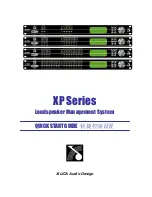
bellagio Digital Entry System
PD
–
281 Issue 1
Installation and Operating Manual
Page 34 of 52
Common Numbering Schemes
In many buildings the flat numbering does not follow a single sequence as illustrated
above; there are often separate sequences for each floor and each sequence begins with
a different number (e.g. 101.. 201.. ). Most requirements can be achieved by adding an
offset address to each Isolator. This offset enables any start address (i.e. the address of
the first flat) to be set between 1 and 3200.
The offset address is set using dipswitch SW7:
SW7 switch
Offset
Example
[q2e4t6ui]
^ ^ ^
+2 +100 +400
Total offset = +502
1
+1
2
+2
3
+50
4
+100
5
+200
6
+400
7
+800
8
+1600
Simply add the Total offset value of SW7 switches to the addresses selected by SW6 (See
the table on page 33).
Example: First Floor 101-108, Second Floor 202-209:
Isolator
(DBA-4I)
Address
Range
SW6
Position
SW7 setting
Comment
1
101-104
1
(1-4)
4 ON
(+100)
Choose 1-4 then add offset of +100
2
105-108
2
(5-8)
4 ON
(+100)
Choose 5-8 then add offset of +100
3
202-205
1
(1-4)
1, 5 ON
(+201) Choose 1-4 then add offset of +201
4
206-209
2
(5-8)
1, 5 ON
(+201) Choose 5-8 then add offset of +201
Unused phone connections
–
Important
It may be desirable to use less than 4 connections on a given isolator for convenience of
cable or building layout. E.g. if there are 3 flats on each floor: use one isolator per floor.
However it is important that in any numbering scheme there are no duplicate flat
addresses or the corresponding phones may not operate correctly.
All unused outputs
should therefore be disabled
.
















































